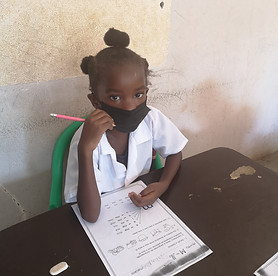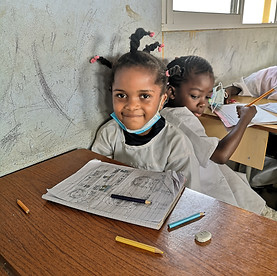PROJECT IN ANGOLA
"Without instruction, without awareness, without education, no human, social, health or economic development is possible."
support operations
to Angolan children
Children do Amanhã aims to facilitate and enable access to knowledge and understanding.
The association's first project aims to address the difficult situation of schooling for Angolan children, particularly those living in rural areas.
Context
Why Angola ?
An improving education system but where much remains to be achieved!
Angola, despite significant structural investments* made in recent years, particularly in education and higher education, the deficit remains considerable: 13.4% of young people under 18 have never attended school and only 13% of young people aged 18 to 24 have been able to complete secondary education .
Although the primary school enrollment rate has increased significantly, it is still only 76% and, more importantly, only 30% complete it.
* supported in particular by the European Union, UNESCO and the World Bank.

An "officially" free education
Angola: a young population
Of the 32 million Angolans,
46% are under 14 years old .
(source: World Bank - 2019)
The new basic law of 2016 reaffirmed the free nature of extended education up to the end of the first cycle .
In practice, the lack of places in schools, administrative and pedagogical controls, as well as the absence of supplies often lead directors, teachers and managers to ask for a "contribution" from parents , which can range from the registration of the student to the publication of their grades or promotion to the next class.
This widespread practice is eating away at the education system, as it is at Angolan society as a whole.
24% of children aged 5 to 11 are still excluded from the school system

The education system for children under 11 years of age consists of :
-
Preschool education
Intended for children aged three to six, kindergarten culminates in a final year of compulsory formal education (introductory class). In practice, very few public institutions have the capacity to offer this often fee-based class.
-
General education
It includes primary education, which lasts six years, and secondary education, which is itself subdivided into two three-year cycles.
In the new law, primary education is further clarified and divided into three two-year learning cycles, with educational assessments taking place only at the end of the second year.
Inequalities in access to education between urban and rural areas
There are significant inequalities in access between urban and rural areas: the net primary education attendance rate is 78% for urban areas and 59% for rural areas.
In secondary education, this rate drops to 50% in urban areas and 14% in rural areas.
Sources:
Pierre Homerin, “The reform of the Angolan education system in 2016”, International Review of Education of Sèvres - find out more
World Education Data – Angola - Revised version September 2010 - learn more
Angola: Literacy level and share of 0-14 year olds in the total population - find out more

Project completed
Human trip to Angola
In May 2021, an exploratory trip was made by the president of the association to Angola.
Its objective:
Reach out to Angolan populations, particularly in rural areas.
Determine the essential needs that enable children to continue their schooling.
- Measure local obstacles and build links for future logistics relays
Container for Angola
Following the Human Trip carried out in May 2021 in Angola, the "Container for Angola" operation was launched in September 2021.
The aim of this operation is to gather equipment (furniture, tables, PCs, screens, etc.) and school supplies (paper, pencils) to fill a container and then transport it by sea freighter to Angola to support Angolan children in their education.
The project was finalized in September 2023.




